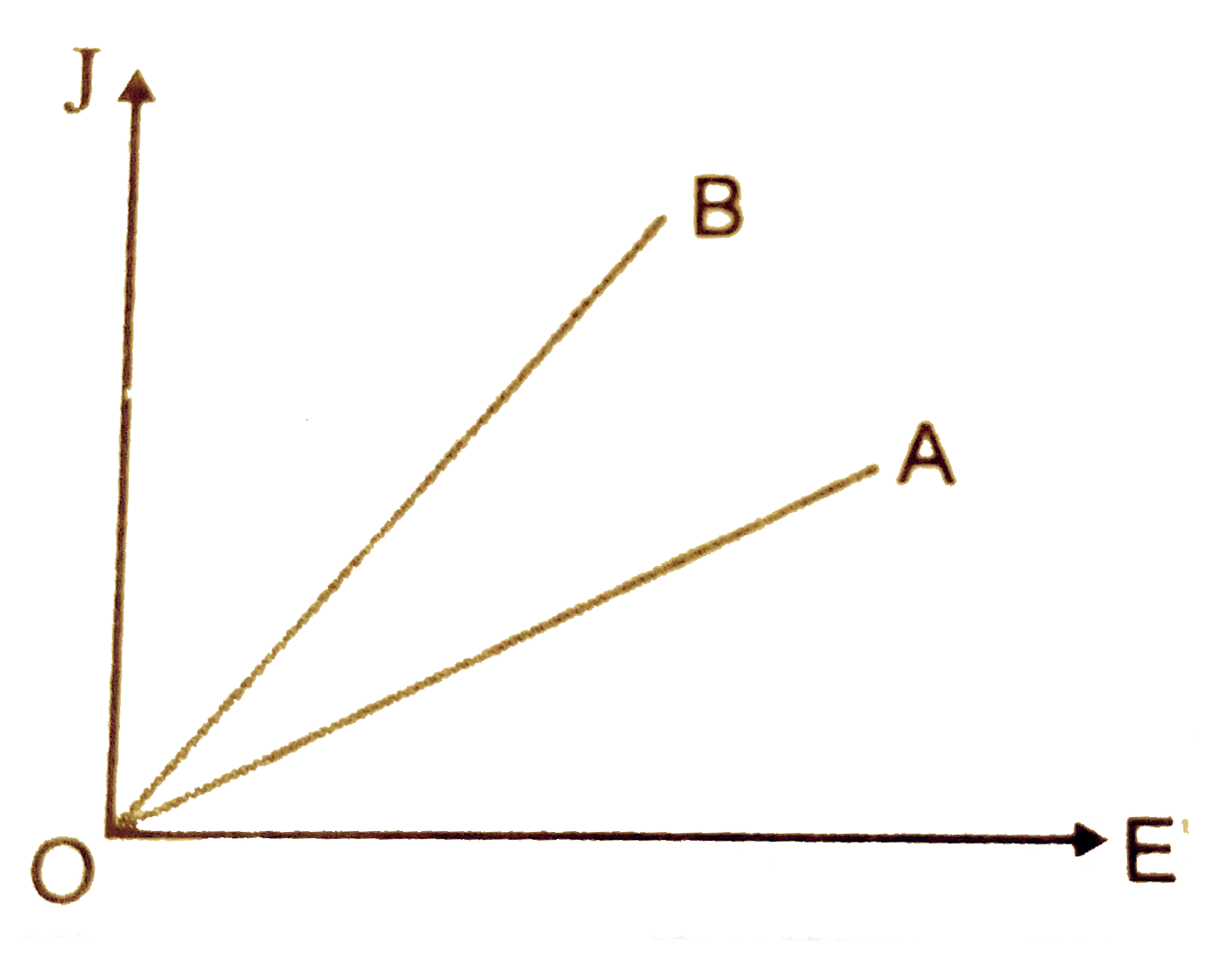Plot a graph showing the variation of current density (J) versus the electric field ( E ) For two conductors of different materials. What information from this plot regarding the properties of the conducting material, can be obtained which can be used to select suitable materials for use in making (i ) standard resistance and (ii) connecting wires in electric circuit?
We know that J=σE or σ=J/E
where σ is the electrical condutivity of the conductor.
The variation of current density ( J) versus the electric field (E ) for two conductors A and B is shown in figure.
Here, the slope of each st. line tells the conductivity of that material.
From graph, σB>σA.
We know that electrical resistivity (ρ) is reciprocal of electrical conductivity.
∴ρAρB=σBσA>1orρA>ρB
The material to be used in making a standard resistance, we require that the resistance of the given conducting wire is large. It will be so if its resistivity is large and its conductivity is small. Therefore, the material A is used in making the standard resistance.
The material to be used in making a connecting wire, we require that the resistance of the given connecting wire is small. It will be so if its resistivity is small and the conductivity is large. Therefore the material B is used in making a connecting wire is the circuit.

Topper's Solved these Questions
- BOOK - PRADEEPCHAPTER - CURRENT ELECTRICITYEXERCISE - Conceptual Problems3videos
CURRENT ELECTRICITY
- BOOK - PRADEEPCHAPTER - CURRENT ELECTRICITYEXERCISE - Very short Q/A7videos
CURRENT ELECTRICITY
- BOOK - PRADEEPCHAPTER - COMMUNICATION SYSTEMSEXERCISE - MODEL TEST PAPER-29videos
COMMUNICATION SYSTEMS
- BOOK - PRADEEPCHAPTER - DUAL NATURE OF RADIATION AND MATTEREXERCISE - Exercise191videos
DUAL NATURE OF RADIATION AND MATTER
Similar Questions
State Joule's law of heating by electric current. Name the materials used to making (i) standard resistors (ii) heater element.
View SolutionAnswer question numbers (a)-(d) on the basis of your understanding of the following paragraph and the related studied concepts :
Oersted demonstrated that an electric current flowing through a conductor produces a magnetic field. The field so produced exerts a force on a magnet placed in the vicinity of the conductor. Ampere suggested that the magnet must also exert an equal and opposite force on the current carrying conductor. The direction of the force on the conductor depends upon the direction of current as well as the direction of magnetic field. Force acting on the conductor is found maximum when the direction of current is at right angles to the direction of the the magnetic field. In such a condition we can use a simple rule to find the direction of the force on the conductor Electric motor, electric generator, microphone, loudspeaker and measuring instruments etc. make use of current carrying conductors and magnetic fields.
An electric motor and a generator both make use of current carrying conductors and magnetic fields, then what is the difference between the two. Give any one point.View Solution
Knowledge Check
- Question 1 - Select One
There is a variety of materials that are used to make components of electrical circuits . These materials have good electrical conductivity . Ispite of having the largest conducivity among metals , silver is not used to make electric wires . Aluminium copper and are generally used to make electic wires .Not only conductors , insulators are alos important .the electrical wires are covered with plastic and rubber like materials . This is used to prevent short circuit and also to protect the user .
What kind of materials are used to make electrical wires in an electric circuit ?AInsulatorsBConductorsCElectrolytesDAll of these - Question 2 - Select One
Amrita is trying to set-up an electric circuit. She runs short of connecting wires. Which of the following materials can she use to complete the circuit ?
ARubber pipeBThick threadCSteel wireDGlass rod
Define resistivity of a conductor. Plot a graph showing the variation of resistivity with temperature for a metallic conductor. How does one explain such a behaviour, using the mathematical expression of the resistivity of a material
View SolutionPlot a graph showing the variation of stopping potential with the frequency of incident radiation for two different photosensitive materials having work functions W1andW2(W1>W2). On what factors does the (i) slope and (ii) intercept of the lines depend ?
View SolutionPlot a graph comparing the variation of potential ‘V’ and electric field ‘E’ due to a point charge ‘Q’ as a function of distance r from point charge
(ii) Find the ratio of the potential differences that must be applied across the parallel and the series combination of two identical capacitors so that the energy stored, in the two cases, becomes the same.View SolutionUsing Einstein's photoelectric equation show how the cut -off voltage and threshold frequency for a given photosenstive material can be determined with the help of a suitable plot/graph.
View SolutionList any two properties of metals which make them suitable to be used as :
(i) Utensils for cooking food.
(ii) Wires for electrical connections.View SolutionIn a series LCR circuit connected to an a.c. source of variable frequency and voltage V=Vmsinωt draw a plot showing the variation of current (I) with angular frequency (w) for two different values of resistance R1 and R2(R1>R2). Write the condition under which the phenomenon of resonance occurs. For which value of the resistance out of the two curves, a sharper resonance is produced ? Define Q-factor of the circuit and give its significance.
View Solution

